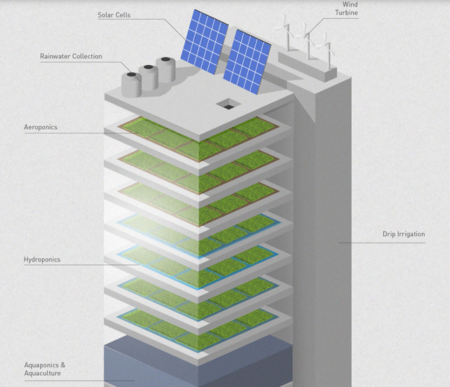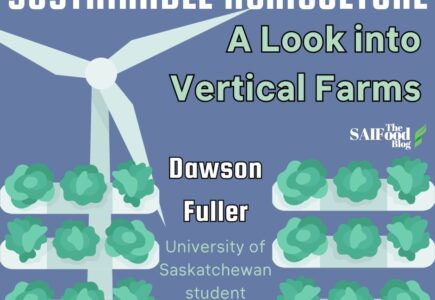By Dawson Fuller
University of Saskatchewan student
Sustainable Agriculture
As Canadians living in a province that contributes heavily to the agriculture sector, Saskatchewanians must help protect the environment using more sustainable practices while producing enough food to feed the growing population. The goal of sustainable agriculture is to meet the needs of today’s society without compromising the ability of future generations to meet their own needs. Given the shortage of land and rising demand for food, solutions that require less land and less labour, yet produce higher yields are needed. Those involved with sustainable agriculture are trying to identify and solve problems in the current agricultural systems to provide long-term food for people in a healthy environment.
Vertical Farms
Vertical farming is one possible solution: growing food in three-dimensional space, providing more food on less land while increasing crop productivity. However, vertical farms have high capital and operating costs. One of the best ways to be fiscally feasible is to grow higher margin produce and refrain from competing with the production of staple crops. Vertical farms can be built almost anywhere: old parking lots, factories, and unused warehouses. All vertical farms use one of three soil-free systems to provide plants nutrients: hydroponics, aeroponics, and aquaponics as seen in Figure 1. Each uses an ecosystem of interacting subsystems: the superstructure, lighting system, nutrient delivery system, plant cultivation system, environmental control system, waste management system, and germination and cleaning system. Using these techniques, the climate of the indoor systems is internally controlled and uses varying levels of LED lights that mimic sunlight.

Vertical farming has many benefits, such as providing maximum output with minimal environmental impact and less space needed. Vertical farms have continuous crop production as they can produce a crop year-round and are much more efficient than traditional farms. The controlled growing conditions in vertical farms allow chemical pesticides to be reduced or completely unused. When needed, some operations use ladybugs and other biological controls to deal with any infestations. Vertical farms have protection from the variability of extreme weather, such as droughts, hail, and floods. Using the hydroponic system allows for roughly a 70% reduction in water conservation than traditional farming. Lastly, vertical farming is more climate friendly. Growing indoor plants reduces the use of tractors and other large equipment used on traditional farms, therefore reducing fossil fuels. Additionally, carbon emissions can be reduced because crops from vertical farms are often transported a few blocks from the facility rather than being trucked or shipped thousands of kilometers away. According to NCAT research specialist Holly Hill, in the United States, fresh produce must travel more than 1,500 miles, before being consumed. This is evident when comparing a vertical farm in Toronto, which produces and delivers lettuce to fast food restaurants in parts of the city, as opposed to importing it from the southern USA in the wintertime.
Call to Action: Why we need to do this
There are more cost-effective solutions than vertical farms at this moment, but it is at an early stage in development. Still, there is a sense of urgency to develop a sustainable agriculture solution to feed our growing population, and this would be a great start. Vertical farms require less usage of land, fertilizer, and water. Yes, it requires a lot of energy, but there are environmentally friendly ways to reduce costs, such as incorporating wind turbines and solar panels. Solar panels can be used to generate electricity that can be used to power lights, fans and other equipment required for plant growth. Furthermore, solar panels can also be used to heat irrigation water. This can further reduce energy costs as well as water consumption.
Another renewable source of energy that can be used is wind power. Producers can install small wind turbines on rooftops, using this energy to produce electricity. These wind turbines can be connected to battery sources that store generated energy for times during periods of low wind. With the worldwide population growth, the demand for more food and land to grow food is ever-increasing. The government should consider this mechanism and drive research and development to help mitigate ways with climate change and achieve more sustainable agriculture practices.
Biography
 My name is Dawson Fuller. I grew up on a farm just outside a small town in Southeast Saskatchewan called Stoughton. I am a fourth year University of Saskatchewan Agribusiness student graduating in spring of 2024. Growing up and working on the farm is what created and drove my passion to further my education in agriculture. As I am near the completion of my degree, I look forward to working in the agriculture sector and continuing my part as it is a thriving industry that feeds the worlds growing population.
My name is Dawson Fuller. I grew up on a farm just outside a small town in Southeast Saskatchewan called Stoughton. I am a fourth year University of Saskatchewan Agribusiness student graduating in spring of 2024. Growing up and working on the farm is what created and drove my passion to further my education in agriculture. As I am near the completion of my degree, I look forward to working in the agriculture sector and continuing my part as it is a thriving industry that feeds the worlds growing population.


